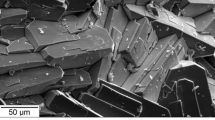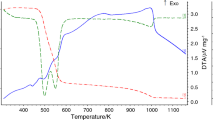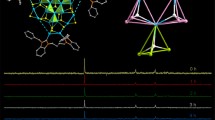Summary
Crystal structure determinations of the non-isomorphous salts, Cu(1,4-thioxane)3(ClO4) and Cu(1,4-thioxane)4(BF4) were carried out. The former compound was shown to contain strongly coordinated perchlorate while the later contains ionic tetrafluoroborate. For the coordinated perchlorate group, Cu-O is 2.278(8) Å. A third compound, Cu(1,4-thioxane)3(H2O)(BF4), was also characterized by x-ray crystallography, and contains a coordinated water molecule (with Cu-O 2.234(7) Å) that is hydrogen bonded to ionic tetrafluoroborate. All three complexes have approximately tetrahedral geometry. The copper(I) atom is coordinated to the sulfur atoms of the 1,4-thioxane rings. In each of the complexes, one of the 1,4-thioxane six-membered rings is coordinatedvia an equatorial ring position and the remaining two or three rings are coordinatedvia an axial position. The compound, Cu(1,4-thioxane)4(ClO4), was also prepared and found to be isomorphous with Cu(1,4-thioxane)4 (BF4), enabling a comparison to be made between the i.r. spectra of ionic and coordinated perchlorate in similar complexes.
Similar content being viewed by others
References
M. M. Olmstead, W. K. Musker and R. M. Kessler,Inorg. Chem., 20, 151 (1981).
B. J. Hathaway and D. E. Billing,Coord. Chem. Rev., 5, 143 (1970).
G. R. Brubaker, J. N. Brown, M. K. Yoo, R. A. Kinsey, T. M. Kutchan and E. A. Mottel,Inorg. Chem., 18, 299 (1979).
F. A. Cotton and G. Wilkinson,Advanced Inorganic Chemistry, 3rd Edit., Wiley, New York, 1972, p. 905.
R. S. McEwen and G. A. Sim,J. Chem. Soc. A, 271 (1967).
J. M. Fowler and A. Griffiths,Acta Crystallogr., B34, 1712 (1978).
J. C. Barnes, G. Hunter, M. W. Lown,J. Chem. Soc. Dalton Trans., 458 (1977).
M. S. Hussain and H. Hope,Acta Crystallogr., B25, 1866 (1969).
R. A. Walton,Inorg. Chem., 5, 643 (1966).
B. J. Hathaway and A. E. Underhill,J. Chem. Soc., 3091 (1961).
A. Anagnostopoulos,J. Inorg. Nucl. Chem., 37, 268 (1975).
R. A. Walton,J. Chem. Soc. A, 1852 (1967).
N. M. Karayannis, C. M. Mikulski, A. N. Speca, J. T. Cronin and L. L. Pytlewski,Inorg. Chem., 11, 2330 (1972).
J. B. Siemak,M. S. Dissertation, University of California, Davis, 1975.
A. L. Balch, L. S. Benner and M. M. Olmstead,Inorg. Chem., 18, 2996 (1979).
International Tables for X-Ray Crystallography, Vol. IV, Kynoch Press, Birmingham, England, 1974, pp. 99–101.
Ibid., pp. 149–150.
Author information
Authors and Affiliations
Rights and permissions
About this article
Cite this article
Olmstead, M.M., Musker, W.K. & Kessler, R.M. Differences in the coordinating ability of water, perchlorate and tetrafluoroborate toward copper(I). The x-ray crystal structures of [Cu(1,4-thioxane)3OClO3], [Cu(1,4-thioxane)3OH2]BF4 and [Cu(1,4-thioxane)4BF4 . Transition Met Chem 7, 140–146 (1982). https://doi.org/10.1007/BF01035827
Received:
Issue Date:
DOI: https://doi.org/10.1007/BF01035827




